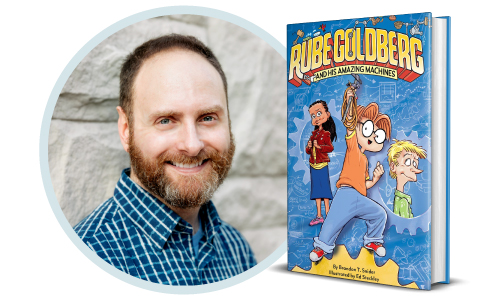When I read on the back cover that this chapter book for middle schoolers had been published with the permission of the Heirs of Rube Goldberg, LLC, I was reassured that the name of the great Jewish inventor and cartoonist (1883-1970) had not simply been appropriated. In this fictional story, Rube Goldberg is a 6th grader, living in modern times, and he is obsessed with building novel machines. You might think of the story as a guess about what the real Rube Goldberg might have been like if he were a kid today.
The fictional Rube has two good friends, Boob (that is not a typo) and Pearl. Boob was how Bob’s name was pronounced by a younger sibling and somehow the name stuck. The name invites Boob’s classmates to make many jokes about body parts, which seems to be the essence of middle school humor. In contrast, Pearl is serious, mature beyond her years, a young woman who is running for class president.
I first heard about this book when it was announced that author Brandon T. Snider was at Comic-Con, hed here in San Diego recently. In an obvious allusion to the nerd-venerated San Diego institution, the plot of the book revolves around the middle school’s Contraption Convention—“ConCon”—at which students’ inventions were to be judged. This competition clearly was something right up Rube’s alley.
So many thoughts come into Rube’s head in rapid succession, it is often hard for him to process what is happening around him. However, when he invents complicated machines that end up doing simple tasks, he is able to hyper-focus – albeit to the exclusion of other important aspects of his life.
Boob and Pearl are mystified and hurt by Rube’s sudden seeming indifference to them, but they don’t give up on their longtime friend. Meanwhile at the school, some strange things occur – lockers are found covered with orange slime; a supposedly haunted doll goes missing – and, to add to the mysteries of the town of Beechwood, an old, decaying house on a hill has a growing assortment of junk on its fenced-off front lawn. That is “junk” in other people’s eyes, but potential treasure for Rube, who sees the land-based flotsam and jetsam as potential building blocks for his creations.
Drawings by Ed Steckley suggest the intricacies of the original Rube Goldberg machines. In one, an apple is rolled down a tilted plane into a cup at the end of a lever to which a string leads to a suspended globe that turns upon impact. The turning globe makes a window shade rise, which causes a hamster wheel to spin, which in turn moves the hands of a clock. In that way Rube and another student, Zach, fool a sleeping teacher into believing that their two-hour detention period has elapsed.
Zach, at one point, comments, “we could just use the ladder and move the clock hands ourselves.”
“Yeah,” answers Rube, “but where’s the fun in that?”
Republished from San Diego Jewish World


























